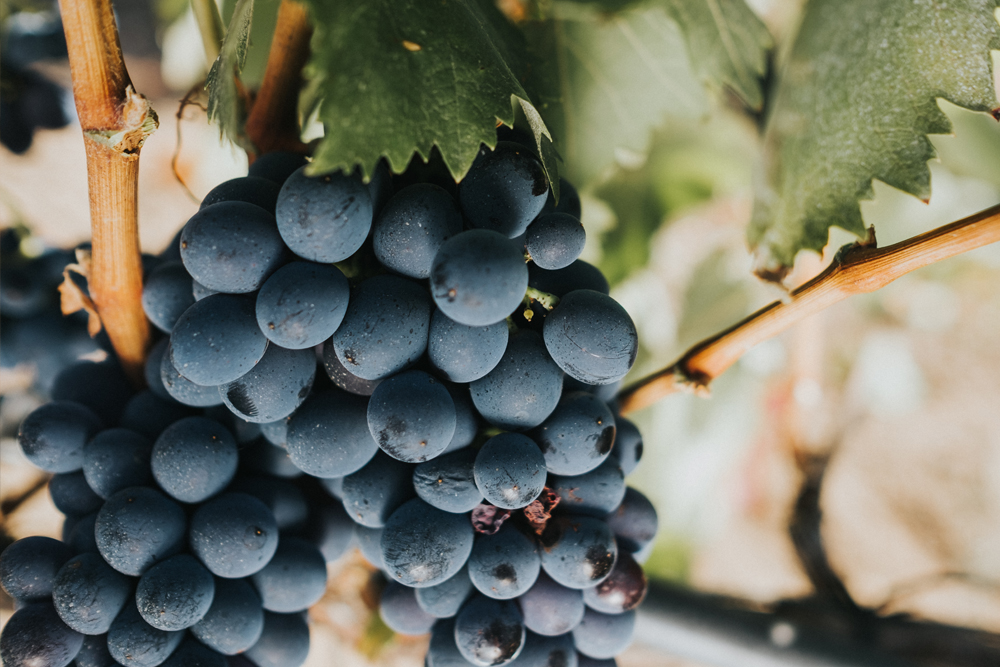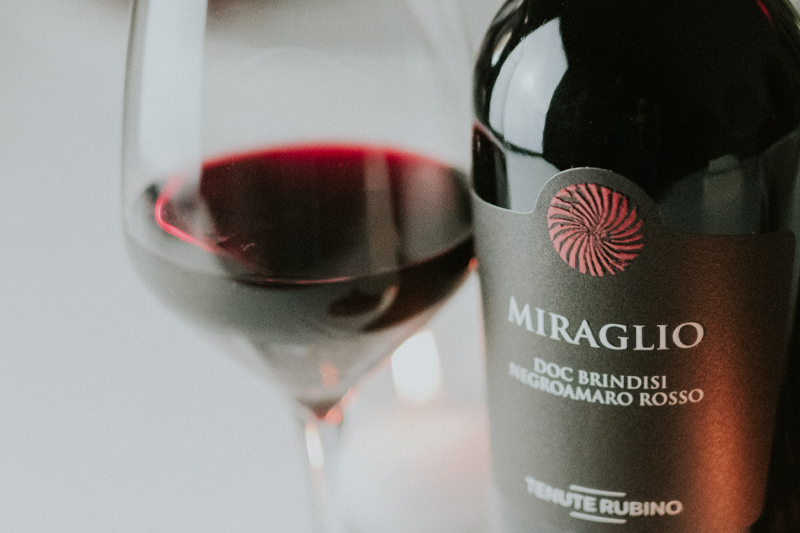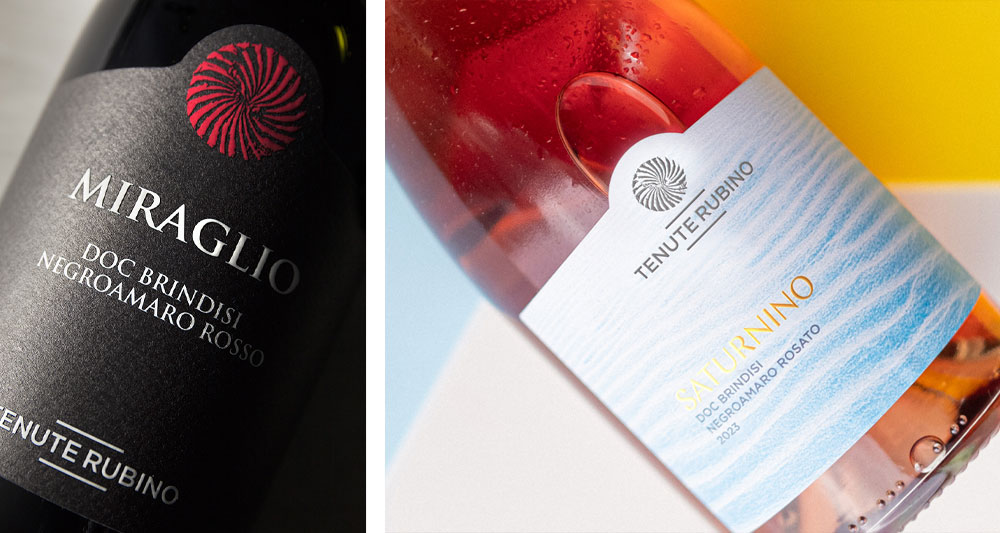-
Jaddico Estate
-
Uggìo-Punta Aquila Estate
-
The Ostuni vineyard
-
Palombara Estate
-
Padula di Geremia Estate
-
Torre Testa
-
Visellio
-
V’itra
-
Jaddico
-
Palombara
-
Oltremé
-
Miraglio
-
Punta Aquila
-
Lamo
-
Sumaré 27 months
-
Sumaré 60 months
-
Salende
-
Libens
-
Lamiro
-
Giancòla
-
Saturnino
-
Oltremé Rosato
-
Torre Testa Rosato
-
Aleatico
-
Aspettando San Martino
-
Cantine Aperte
-
La Vendemmia delle donne
-
RAP
-
Rubino Wine Party
-
Saturnino Wine Party
-
Tenute Rubino Wine & Friends
Negroamaro
Negroamaro: bonded with tradition, it has entrusted its care to a fragment of Salento.
Name and history
Negroamaro is a native black grape variety from Apulia, and more specifically from the Salento area (in the provinces of Lecce and Brindisi negroamaro covers 70% of the vineyards).
Its strong ties with the Salento area are evident from the origin of its name, which derives from the salentine dialect and indicates the two main characteristics of the wine: niuru (nero) black of the grapes and maru (amaro) bitter, referring to the enjoyable bitter finish from the wine’s tannins.
Negroamaro has a long history, beginning in Illyria or Greece with its ancient ancestors. This ancient grape variety was brought to Apulia between the 7th and 8th century BC by the Greeks and it probably debuted in the Salento Ionian coast, a logical assumption given the distribution of the contemporary Negroamaro vines.
Negroamaro most likely began establishing itself in the mid western areas of Apulia and then slowly spread across the region and in other areas of southern Italy.

Varietal Characteristics
Negroamaro is a variety that adapts perfectly to the hot and dry conditions found in Apulia and, in particular, Salento. At the same time it benefits from the temperature ranges and the close proximity to the sea surrounding Salento.
The long exposure to sunlight has a positive effect on Negroamaro vines and it is very tolerant of drought conditions.
The red soil composed of limestone-clay, typical in the Salento area, is the ideal soil type for this variety.
The limestone helps the varietal express itself in the wine with quality and elegance, while the clay helps retain water and is a source of important water reserves for the vine.
Negroamaro is a vigorous variety with high and constant production levels. The traditional vine training method used with Negroamaro is alberello without tresilling, a type of training system defining the typicity and territory in line with Apulian and Salentine winemaking traditions.
The alberello is a symbol of ancient winemaking culture, implicating lower yields for Negroamaro (between 60 and 70 quintals per hectare) but also guaranteeing high quality yields.
Organoleptic characteristics
The Negroamaro grape is extremely versatile and manages to express itself in several variations, most well known for its red but also rosè versions, it even has some white versions, expressing itself in still and sparkling wines.
In terms of its organoleptic qualities, it is consistent with its very elegant fruit aromas, delicate spices and floral notes, its imposing structure, its exceptional balance between acidity and sapidity, and lastly its unmistakable noble and firm tannins.
The flavours this variety brings to the wine are intense, decisive and persistent, with an enjoyable bitter note on the finish, from where the second part of its name takes inspiration “amaro- bitter”.
On the palate Negroamaro has a velvety impact, full bodied and also thanks to its firm tannins it combines vigor and an enjoyable elegance.
The nature of this variety means it is well suited to winemaking techniques with important ageing periods.
Ampelographic Description
Bud burst:
At bud burst the bud has an expanded, cottony apex with a yellowy- white colour and pink- wine coloured edges. The leaflets from the first to the third are eaves, the first two are white and yellow, the third is spread out, wooly and green-yellow in colour. While the fourth leaflet and onwards are almost cupped, velvety and a light green, the bud’s axis is curved in shape.
Shoots:
The shoots are characterised by an almost circular cross section, with a smooth and arachnoid outline, green in colour.
Tendrils:
The tendrils are long and thin, with a bifid form and light green in colour.
Inflorescence:
The inflorescence is average size, with a length of around 13-14 cm and a simple shape, chunky cylindrical-conical.
Flower:
The flower is a hermaphrodite, has a flower bud with a cylindroid form of average size.
Leaf:
The leaf is large with a five-lobed and three-lobed pentagonal shape.The petiolar sinus has a tight V shape, the upper lateral sinuses have overlapping edges and the lower are a little shallower, with a U or closed lyre shape, often with a U followed by a V. The leaf is characterised by an upper green and smooth side, while the lower part is light green, opaque with protruding 1st and 2nd nerves, they are arachnoids, partly red, the edge is cupped, wrinkly and thick; involute lobes, the angle at the top of the terminal lobes is a right angle; the teeth are pronounced, irregular with convex and mucro margins.
The petiole is green with red streaks, is short with a medium thickness and is smooth, the canal is not very evident in the cross section.
Bunch:
The Negroamaro bunch has an average size and a simple, conical shape. It is around 14-20 cm in length, the peduncle is visible, woody for the first 2 cm and average size.
Seeds:
An average number of 1-3, pyriform, with a medium length and sized beak.
Grape:
The grape is medium size (15-18mm) and has a normal obovoid shape with a prominent and clear navel and with a circular cross section.
The skin is thick and consistent, purple in colour.
The flesh is juicy with a neutral flavour and coloured juice; it is known for its wine coloured juice. The pedicel is easily detached from the grape. The pedicel is medium length and size, is green in colour and is easily separated from the grape, it is a rusty green colour and the brush is average size and amber yellow in colour.
Cane:
The cane is average length, robust, with few branches and a resistant bark and an elliptical cross section, smooth surface with little bloom, arachnoid only at the base of the cane, hazelnut in colour.
The nodes are globes with internodes that go from 6.6cm to 7.5 cm in length. The buds are round and cottony.
The petiole is large and protruding, descending rectilinear; convex diaphragm, the medula is average thickness and the wood is resistant when cut.
Trunk:
The vine’s trunk is vigorous and robust.
Phenology
Vegetative Phenomenon
Negroamaro is a late budding variety and the grape maturation is medium- late, generally between the end of September and the beginning of October. Budding occurs in the last ten days of March and flowering at the end of May. Veraison happens between the end of July and the end of August. The grapes reach full maturation between the end of September and the first ten days of October.
Cultivation aptitudes and characteristics
Vigor: Excellent
Production: The production is constant, plentiful and of good quality.
Positioning of the first bud: 2nd knot
Average number of inflorescences per bud: 2-3
Lateral shoots fertility: almost nothing, with the exception of the first years of planting, but the raceme are not used.
Multiple grafting development: normal.
Compatibility with American rootstock: Good compatibility with all American rootstocks, easily grafted. Some say it isn’t compatible with the R. Metallica.
The wines
Tenute Rubino presents its wines as three different expressions of the same variety: Miraglio is one hundred percent Negroamaro from the Uggìo Estate, while Jaddico and Saturnino are both from the Jaddico Estate. The first is a blend of Negroamaro with a small amount of Susumaniello to refine it, and the second shows the typical Salentine tradition of Negroamaro rosè winemaking.

